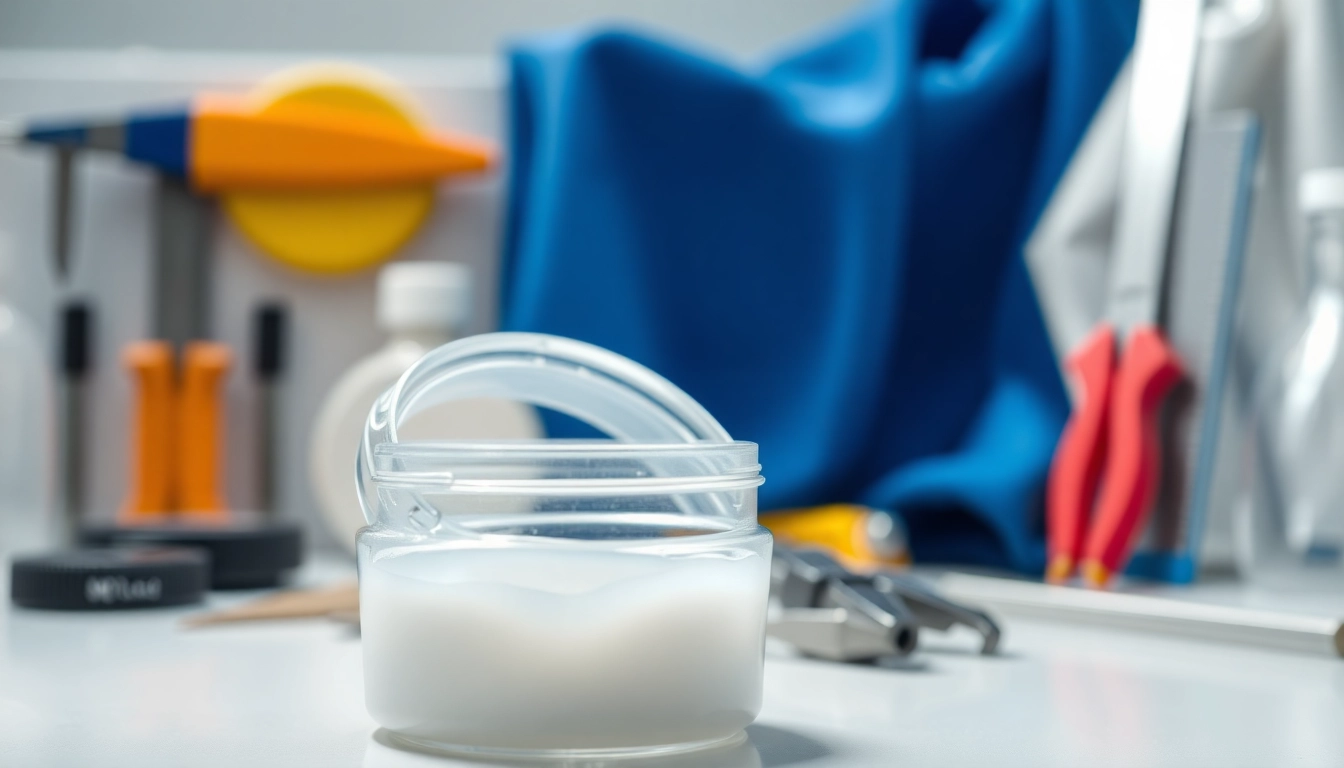What is Laminating Resin? An Overview
Definition and Composition
Laminating resin is a versatile and essential material primarily used in composite constructions. A synthetic resin, it serves as a binding agent that creates a strong bond between layers of fabric, most commonly fiberglass, resulting in a lightweight yet robust structure. The composition of laminating resin typically involves two key components: resin and hardener. When mixed, these components undergo a chemical reaction that causes the resin to cure and solidify, forming a hard and durable layer that can withstand various stresses.
Commonly synthesized from unsaturated polyester or epoxy, laminating resin possesses distinct properties that define its performance in various applications. Polyester laminating resins are known for their affordability and ease of use, while epoxy variants are favored for their superior adhesion and mechanical strength. Depending on the formulation and intended use, laminating resins may also include additives that enhance specific properties like UV resistance, flexibility, and curing time.
Types of Laminating Resin
There are primarily two types of laminating resins: polyester and epoxy.
- Polyester Laminating Resin: This type is generally the most widely used for marine applications as well as for construction and automotive projects. Its fast curing time and affordability make it attractive for hobbyists and professionals alike. However, polyester tends to be less resistant to moisture and temperature variations.
- Epoxy Laminating Resin: Although typically more expensive than polyester, epoxy laminating resins offer superior adhesion, flexibility, and resistance to environmental elements. They also bond exceptionally well with a variety of substrates, ensuring a long-lasting finish. Epoxy resins are preferred in high-performance applications such as aerospace, automotive, and high-end marine manufacturing.
Common Uses and Applications
Laminating resins are extensively utilized across various industries due to their versatility and strength. Some common applications include:
- Marine Construction: Laminating resins are integral in the fabrication of boats, canoes, and other marine vessels because they provide a waterproof barrier and structural support.
- Automotive Industry: In the manufacture of body panels and other composite components, laminating resins contribute to the weight reduction and enhanced durability of vehicles.
- Furniture Making: In the furniture industry, laminating resins are used to create strong, composite materials that can be molded into intricate shapes.
- Building and Construction: These resins are employed in the construction of reinforced concrete and precast panels, ensuring long-lasting structural integrity.
- Sports Equipment: High-performance sports gear, such as surfboards and bicycles, often utilizes laminating resins for their optimal strength-to-weight ratio.
Comparing Laminating Resin with Other Resins
Laminating Resin vs. Epoxy Resin
While both laminating resin and epoxy resin serve as adhesives and structural binders, they exhibit significant differences:
- Curing Process: Laminating resins, particularly polyester, cure through a chemical reaction with a catalyst, whereas epoxy may involve either a one-part or two-part system requiring precise mixing.
- Cost: Generally, laminating resins such as polyester are more cost-effective than epoxy, making them suitable for budget-sensitive projects.
- Adhesive Strength: Epoxy resins tend to outperform laminating resins in tensile strength, flexibility, and impact resistance, making them preferred for applications demanding a high degree of durability.
Polyester Laminating Resin: Pros and Cons
Choosing polyester laminating resin comes with its unique set of benefits and drawbacks. Its primary advantages include:
- Cost-Effectiveness: Generally, polyester is less expensive than its epoxy counterpart, allowing for larger projects at a lower price point.
- Ease of Use: Polyester resins are user-friendly and cure quickly, which accelerates project timelines.
- Good for Mold Making: They work well for creating molds and forms due to their relatively low viscosity.
However, the drawbacks of polyester laminating resin include:
- Lower Strength: While sufficient for many applications, polyester typically has lower bond strength compared to epoxy.
- Vulnerability to UV Damage: Polyester can degrade under prolonged exposure to sunlight unless protected with a UV-resistant coating.
- Odor and Volatility: This resin type emits a stronger odor and volatile organic compounds (VOCs), necessitating proper ventilation during application.
Common Misconceptions about Laminating Resin
Several common misconceptions exist regarding laminating resin that can hinder effective usage:
- All Resins are the Same: It’s vital to understand that not all resins serve the same purpose; selecting the right type for specific applications is crucial.
- Laminating Resin is not Strong: Though its strength might be perceived as inferior to epoxy, laminating resin can provide adequate structural support for numerous applications.
- Only Professionals Can Use Laminating Resin: While skill and practice improve usage, many hobbyists can successfully use laminating resins with proper guidance and preparation.
Key Benefits of Using Laminating Resin
Enhancing Structural Integrity
Laminating resin significantly contributes to the structural integrity of composite materials. The resin binds layers of reinforcement, such as fiberglass cloth, creating a solid structure that can withstand various mechanical stresses and loads. This feature is particularly beneficial in industries requiring strength and durability, such as marine and automotive sectors. A well-laminated product ensures enhanced performance and longevity, reducing maintenance and replacement costs.
Improving Adhesion and Compatibility
Laminating resin’s formulation allows for exceptional adhesion to various substrates. This compatibility fosters the creation of multi-material structures without compromising strength or performance. Its adhesion properties make it an ideal choice in applications where different materials meet, such as bonding fiberglass to wood or metal surfaces.
Versatility in Application
The versatility of laminating resin extends across various applications, from small-scale projects like crafting to large-scale industrial uses. Its ability to be used in many settings makes it a valuable material for professionals and DIY enthusiasts alike. Whether creating custom moldings or repairing damaged fiberglass structures, laminating resin adapts to numerous requirements, enhancing its utility.
Best Practices for Using Laminating Resin
Preparing Your Workspace
Creating a productive workspace is essential for avoiding complications during the curing and application processes. To ensure optimal results, consider the following:
- Ventilation: Ensure your workspace is well-ventilated to mitigate fumes and vapors emitted during the curing process.
- Temperature Control: Maintain a stable temperature, ideally between 65°F and 85°F (18°C and 30°C), to ensure proper curing.
- Clean Environment: Remove dust, debris, and contaminants from surfaces and tools to enhance adhesion and finish quality.
Step-by-Step Application Process
Applying laminating resin requires careful attention to detail. Follow these steps to achieve the best results:
- Gather materials, including the resin, hardener, brushes or rollers, measuring cups, and safety gear.
- Measure curable components accurately based on the manufacturer’s guidelines.
- Mix the resin and hardener thoroughly in a clean container to ensure uniform consistency.
- Apply the mixed resin onto the preparation surface using a brush or roller, focusing on complete coverage.
- Layer your fiberglass or other reinforcement materials upon application, ensuring full saturation.
- Continue layering resin and materials until the desired thickness is achieved.
- Tool and smooth the surface as needed, followed by allowing sufficient curing time as specified.
Safety Considerations and Precautions
Safety is paramount when working with laminating resin. Follow these precautions:
- Always wear appropriate personal protective equipment (PPE), including gloves, goggles, and a mask or respirator.
- Study the safety data sheets (SDS) for the specific resin being used to understand its hazards and first aid measures.
- Keep flammable materials away from the workspace and ensure fire safety protocols are in place.
Measuring Performance and Outcomes
Assessing Application Quality
Post-application assessment is crucial to determine the quality of the work completed. Factors to consider include:
- Surface Finish: Evaluate the smoothness, gloss, and overall appearance of the cured resin surface.
- Bond Strength: Conduct tests to determine the adhesion quality between the resin and reinforcement materials.
- Curing Consistency: Ensure the resin has cured evenly without any soft spots or uncured areas.
Common Performance Metrics
Performance can be quantified based on various metrics, including:
- Tensile Strength: A measure of how much pulling force a material can withstand without failure. This is pivotal in determining structural suitability for specific applications.
- Flexural Modulus: This metric assesses how well a material can resist bending forces and is crucial for applications under load.
- Impact Resistance: Ability to absorb stress and resist fracture under sudden loads or shocks.
Evaluating Long-Term Durability
Assessing the durability of laminating resin applications is essential for determining their longevity. Factors that contribute to durability include:
- Environmental Resistance: Evaluate how well the resin withstands exposure to moisture, UV light, and temperature fluctuations over time.
- Fatigue Resistance: Monitor the material’s performance under repetitive stresses and cycles, particularly in applications subject to continuous use.
- Maintenance Requirements: Determine how often maintenance is needed to ensure the integrity and performance of the resin application.



